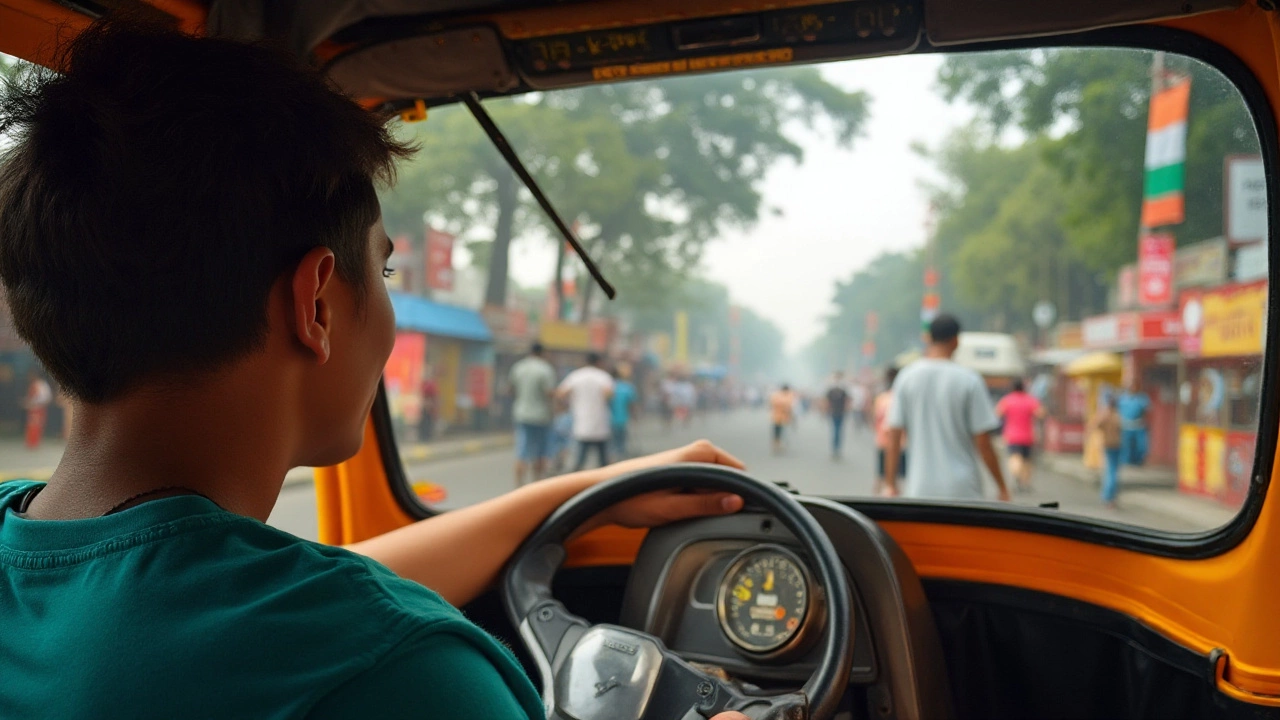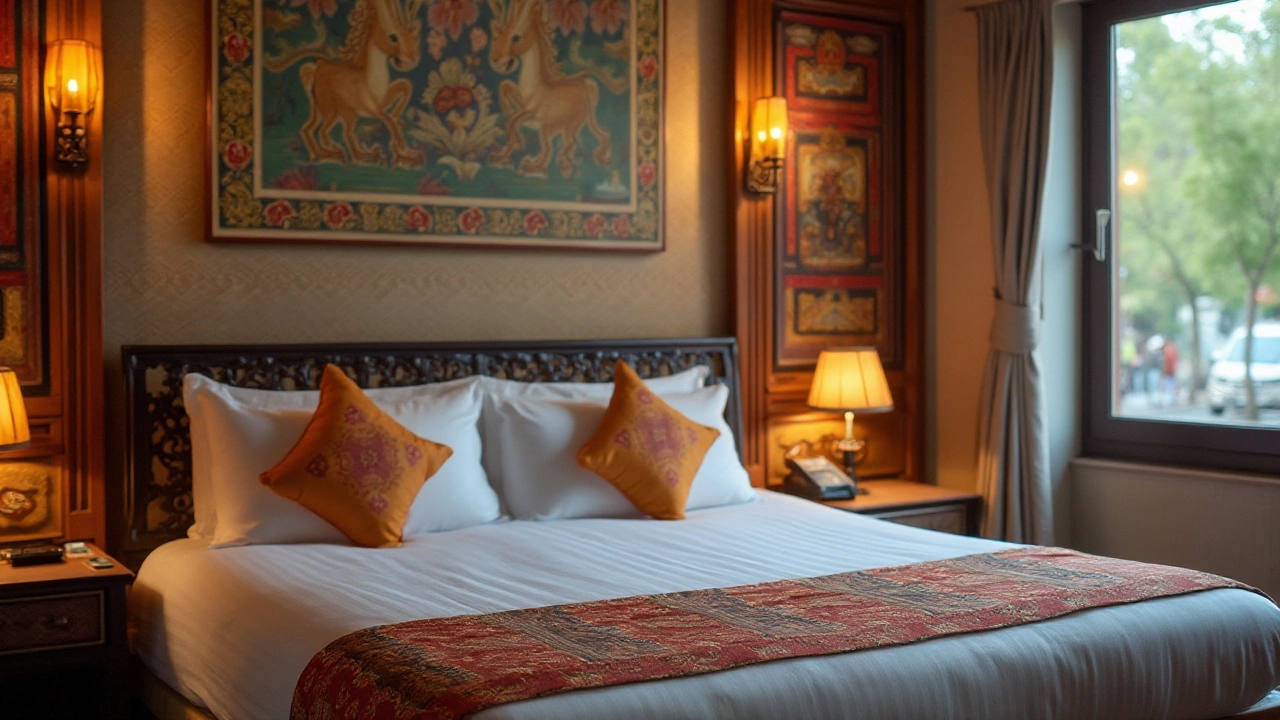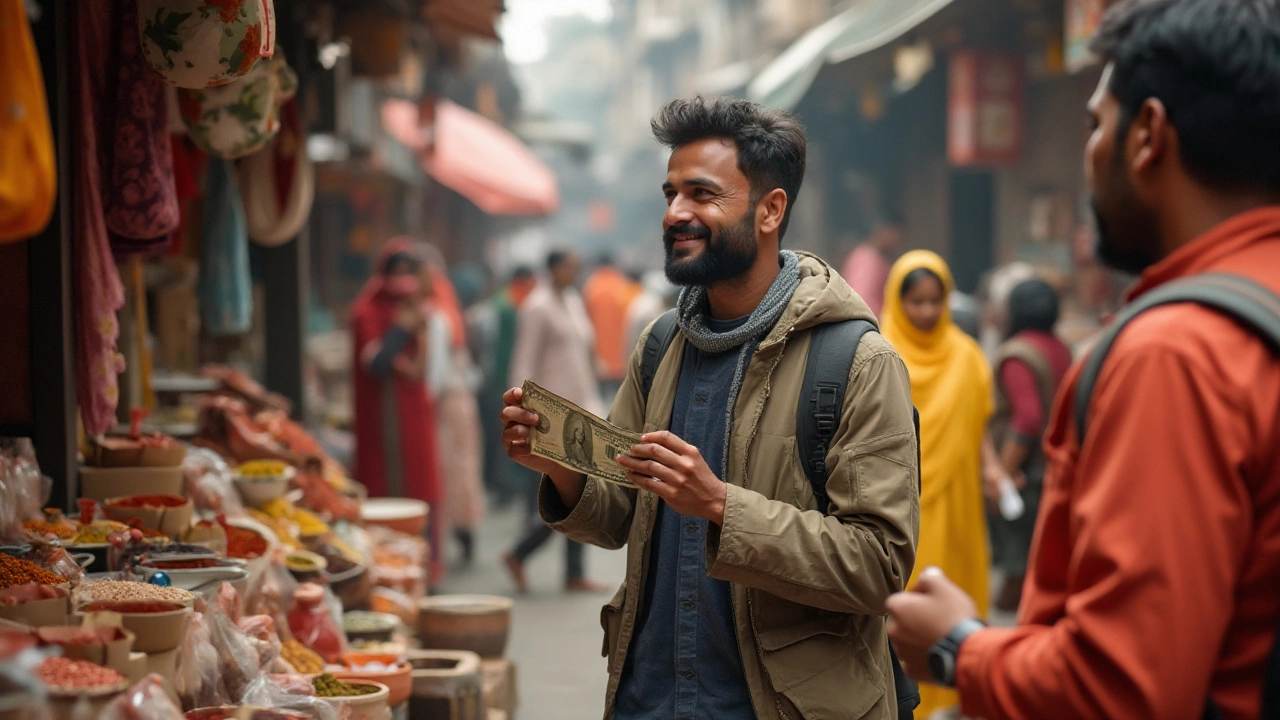Embarking on a journey to India on a budget can be an exciting adventure filled with rich cultural experiences and eye-opening discoveries. Knowing how much $1 US can stretch in this vast country is essential for making the most of your trip. As of today, January 19, 2025, the exchange rate may vary, and understanding its implications on your travel budget is crucial.
From savoring local delicacies to navigating bustling city streets, every dollar counts when you're exploring India. In this article, we'll dive into the current exchange rate, share some insights into day-to-day costs, and offer tips on how you can make your dollar go further. Whether you're a seasoned traveler or visiting for the first time, this guide aims to enhance your travel experience on a shoestring budget.
- Current Exchange Rate Analysis
- Budgeting for Daily Expenses
- Affordable Accommodation Options
- Exploring Transportation on a Dime
- Cultural Experiences Worth Every Penny
Current Exchange Rate Analysis
When planning a trip to India, understanding the fluctuations and trends in the currency exchange rate between the US dollar and Indian Rupee can be a vital part of managing your expenses. The rate at which a USD to INR exchange happens doesn't just affect travelers; it significantly influences businesses and the economy at large. As of recent observations, the rate has been hovering around 82 to 85 INR per US dollar, although it's crucial to check reliable sources for the most up-to-date figures before exchanging money. This rate can provide a traveler with some ground to stretch their dollars further, enabling them to enjoy more activities or stay longer.
Currency values fluctuate based on a myriad of factors such as economic conditions, government policies, inflation rates, and market speculation. India's economic growth, governmental fiscal policies, and trade balances often contribute to the strengthening or weakening of the Rupee against the Dollar. For travelers, such fluctuations can mean the difference between a budget-friendly vacation and an unexpectedly costly one. If taking advantage of a favorable exchange rate, visitors can access better deals on accommodations, dining, and transport, making their journey more financially feasible.
Even though the exchange rate gives a numerical tooltip, the administrative overhead like bank service charges, transaction fees, and foreign exchange premiums may skew this number slightly. While it might seem daunting to leave this aspect of planning to the last minute, several banks and forex services provide competitive rates and options for currency pre-order in your home country. Using credit cards with minimal or no foreign transaction fees can be a smart decision, though it's always best to keep some cash handy for small vendors and establishments.
A wise traveler once remarked in an article from The Economist, "Understanding the pulse of a country's currency can teach you about the way its heart beats."
Exchange isn't merely about money; it's about reciprocity and mutual benefit, whether you're purchasing spices at a bustling market or haggling for a handcrafted souvenir in the vibrant streets of India.Monitoring exchange trends may also provide insights into broader economic phenomena, granting travelers an educated perspective on spending wisely. Recognizing seasonal and cyclical changes in currency values can help foresee the best times to finance international travels or transfers.
Those familiar with exchange rate predictions often monitor specialized financial news or subscribe to reports from reputable financial advisories. Setting up alerts for currency rate highs and lows can help decide when to purchase in advance or potentially convert back any leftover Rupees after a trip. Regardless of the economic climate, seizing opportunities where advantageous can make your journey an enriching experience—not just culturally, but financially as well.
Budgeting for Daily Expenses
When traveling in India, understanding how to budget for daily expenses can transform your experience into an enriching adventure without breaking the bank. India's allure is in how it offers a plethora of experiences at varied price points, making it a haven for budget travelers. Imagine waking up in a bustling city or serene countryside with the knowledge that your dollar goes a long way if spent wisely. As of January 2025, the exchange rate is typically fluctuating between 70-75 Indian Rupees for $1 US, offering substantial purchasing power to those savvy enough to plan.
Street food in India is not only famously delicious but also incredibly economical. A wholesome meal or street snacks can cost as little as 50 INR, sparking joy for both your taste buds and your wallet. **USD to INR** conversions favor those willing to delve into local markets. Fruit from street vendors, for instance, can be purchased for just a few rupees, making it easier to maintain a healthy diet without excess spending. While meals in upscale restaurants can range from 500 INR up, the authentic experience of dining in smaller eateries—known locally as dhabas—can provide you with a satisfying meal for less than 150 INR.
A seasoned traveler once remarked in Lonely Planet, "Dining with locals not only saves money but offers insight you won't find in guidebooks."
Public transportation like buses and trains are incredibly affordable, with short distances costing under 50 INR. Unlike in Western countries where a cab ride can severely dent your travel budget, services like rickshaws or shared taxis are abundant and laid-back, averaging around 100-200 INR for medium distances. For the eco-conscious traveler, cities like Delhi have efficient metro systems, offering daily passes that go for about 60 INR, allowing you to explore the city without worry.
Tracking Expenses
To maintain your **travel budget India**, it’s handy to know how much you're spending per day. Mobile apps can help track your expenses, allowing you to adjust on the go. Consider allocating a daily budget and sticking to it firmly. Guidelines suggest that a budget traveler might spend around 2000 INR per day in India, including accommodation and meals. This allocation permits occasional splurging, such as indulging in an Indian sweet dish or taking an entry fee for a museum. But always keep an eye out for possible markdowns and discounts at your hostel or tourist sites.
Table of sample costs:
| Item | Cost in INR |
|---|---|
| Street Food Meal | 50-100 |
| Local Bus Ticket | 10-30 |
| Budget Hostel (per night) | 500-1000 |
| Museum Entry Fee | 200 |
Planning your adventure in India with these expenses in mind not only makes budgeting simpler but also enriches your travel experience by offering a more immersive approach to local culture and routines. Use your **currency conversion** wisely and let every penny count while you explore the diverse and vibrant landscapes of India!

Affordable Accommodation Options
Travelers venturing into India can find a plethora of affordable accommodation options tailored to budget-conscious explorers. One popular choice is the backpacker hostels that have rapidly gained popularity among young travelers and solo adventurers. These vibrant establishments not only offer cost-effective rates but also provide a sense of community where you can swap stories with fellow travelers. Most hostels now include clean dormitories with bunk beds, secure lockers, and access to Wi-Fi, making them an ideal choice for those looking to stretch their dollar. In cities like Delhi and Mumbai, you're likely to stumble upon hostels in cultural hotspots, allowing you to dive into the city's heartbeat without breaking the bank.
For those who prefer a bit more privacy but still within budget, budget hotels and guesthouses offer excellent alternatives. These establishments can be found throughout the country, ranging from the bustling streets of Kolkata to the serene beaches of Goa. Many budget hotels now provide amenities such as en-suite bathrooms, room service, and even complimentary breakfast, giving you more than just a place to rest your head. A particular favorite among travelers is the quaint guesthouses in Rajasthan, where the charm of traditional architecture meets modern comfort without the hefty price tag. With rooms averaging between 500 to 1500 INR per night, staying within your financial plans while exploring India has never been more achievable.
For an authentic cultural experience, consider staying in a homestay. This form of accommodation allows you to immerse yourself in local life and customs, often including delicious homemade meals and invaluable insights from your hosts. Homestays offer a unique perspective of the Indian way of living, extending beyond the generic tourist track. Depending on the region, prices fluctuate, but guests can expect warm hospitality and personalized service, often making these experiences the most memorable parts of their travels.
From a financial standpoint, comparing accommodation options before booking can make a significant difference. Websites and apps such as Booking.com and Airbnb have user-friendly platforms where you can filter results based on price, location, and guest reviews. Keep an eye out for special off-season deals or flash sales, which can result in even greater savings. According to a survey by the Economic Times, travelers were able to save an average of 20% on accommodation by booking during off-peak times or utilizing loyalty programs.
"India offers a diverse range of accommodations to suit every budget, but planning ahead can ensure you secure the best deals," advises travel expert Nomadic Matt, highlighting the importance of preparation in budget travel.
While considering your accommodation options, it's worthwhile to evaluate the value of currency conversion on your choices. A little extra research and a bit of flexibility can go a long way in ensuring that your Indian journey is enriched without straining your wallet. Whether choosing the social environment of a hostel, the comfort of a budget hotel, or the warmth of a homestay, India promises an affordable stay tailored to your adventure.
Exploring Transportation on a Dime
Preparation is the key to making your travel experience both efficient and economical, especially when it comes to exploring India by public transport. One of the great things about traveling here is the variety and affordability of transport options available to budget-conscious travelers. From vast railway networks to auto-rickshaws zipping through the streets, the choices are plentiful. First-time visitors to India might find the hustle of navigating through crowded public transportation intimidating, but with a bit of insight, it can turn into one of the most enriching parts of your journey. Knowing how to maneuver through these options can save both time and money, leaving more resources to spend on those memorable experiences.
The Indian Railways, one of the world's largest railway networks, offers extensive coverage across the nation – connecting metropolitan cities, quaint villages, and everything in between. Traveling by train is not only affordable but also provides an opportunity to see the enchanting landscapes of the country. Sleeper class tickets, the most economical choice, offer basic amenities and are sought after by both locals and intrepid travelers eager to interact with fellow passengers. Remember, the earlier you book the tickets, the better chances you'll have at snagging seats during popular travel times. Bear in mind to keep an eye out for Tatkal tickets, especially if your travel plans change abruptly, as these are a last-minute saving grace for many.
Another option that’s gaining popularity among budget travelers is the extensive bus network. From state-run services to private operators, buses in India can connect you to destinations unreachable by train. It's worth noting that buses vary greatly in terms of comfort and cost, with luxury and sleeper buses costing a premium. In contrast, the regular ones provide a cost-effective way to get around, though expect things to be less cushy. As an anecdotal piece of advice, a seasoned backpacker once shared, "Always pack a travel pillow for those overnight bus rides – you may not need a bed but a little neck support goes a long way."
For those looking to cover shorter distances within cities, auto-rickshaws, often synonymous with Indian roads, are unbeatable for speed and maneuverability through traffic-clogged streets. Always negotiate the price before you hop in, or better yet, ask your accommodation about the going rates to avoid tourist surcharges. Alternatively, ride-sharing apps have revolutionized intra-city transport, balancing convenience with affordability and transparency in rates. Not only do these provide door-to-door services, but they also allow you to customize rides according to budget and comfort level, with many offering options for carpooling to further cut costs.
Perhaps the least expected yet rewarding way to absorb local color and charm is by joining bicycle tours in urban areas and scenic towns. Often organized by local communities and tourism boards, these tours charge modest fees and are guided by knowledgeable locals who provide insight otherwise unavailable through guidebooks. Bicycle rentals allow tourists to navigate at their own pace and explore nooks and crannies missed by faster and larger transport. Days spent cycling around can reveal hidden gems within bustling cities or tranquil rural expanses often overlooked during whirlwind tours.
Lastly, we wouldn’t want to overlook the value of simply walking. Particularly in compact towns and cities like Jaipur or Pondicherry, the compact nature of many tourist spots invites exploration on foot. Many travelers marvel how they rediscover simple joys when immersing themselves in local scenes this way – impromptu interactions, spontaneous discoveries, and an intimate connection with the pace of life that vehicles often zoom past. Not only is it cost-free, but it also represents the purest form of travel: direct, spontaneous, and personal.
Delve into India's vast and varied transportation landscape with the practical tips outlined above, and you'll make your way through this captivating country without breaking the bank. Each mode of transport fits into a unique experience, offering its slice of life on a budget that’s hard to top elsewhere. So go ahead, explore this great land, armed with knowledge and the assurance that affordable and thrilling journeys await at every turn.

Cultural Experiences Worth Every Penny
Immersing oneself in Indian culture doesn't require breaking the bank. With just $1 US, travelers can dive into an array of cultural experiences that are both enriching and memorable. A visit to one of India's many vibrant markets can be a feast for the senses and an insight into daily life. These markets offer a whirlwind of colors, scents, and sounds where you can purchase handcrafted trinkets, spices, and textiles without spending a fortune. Just imagine strolling through a spice market, with the air filled with a blend of turmeric, cumin, and coriander. The locals, eager to share their stories and heritage, can enhance the experience, making each interaction priceless.
An evening spent watching a traditional dance performance, such as Kathakali or Bharatanatyam, can transport you through centuries of history and culture. These performances, often held in community spaces or historic venues, offer not just entertainment, but a window into India's artistic traditions. Watching local artists narrate tales of old through intricate gestures and vibrant costumes is surely worth your dollar. In some regions, you might even find street performances or practice sessions open to the public. As Rudolf Nureyev famously said,
"Dance is your pulse, your heartbeat, your breathing. It's the rhythm of your life."Experiencing Indian dance is certainly a heartbeat of its cultural essence.
Food is another delightful gateway into understanding a culture, and India offers a bountiful array of street food that ranges from snacks like samosas and paani puri to hearty meals like biryani. With a dollar in hand, sampling an assortment of street food is not only attainable but advisable. Each region has its specialties, with flavors and spices that tell the story of its heritage. Whether you're savoring the tangy taste of chaat in Delhi or indulging in the savory goodness of idlis in Chennai, these local delicacies are bound to leave you both satiated and inspired to learn more. Plus, engaging in a meal that locals cherish provides insight into their everyday lives and their culinary traditions.
Aside from food and entertainment, tapping into cultural events and festivals can be equally rewarding. In a country where festivals are as frequent as the changing seasons, attending any of these celebrations can offer remarkable insights into community spirit and cultural traditions. Whether it’s the jubilant chaos of Holi or the serene traditions of Diwali, these festivals are vibrant expressions of India’s diverse culture. Often, local communities welcome travelers into these celebrations, offering them a firsthand experience of their joyous customs. Participating in these events, even as an observer, enriches your understanding of local traditions and potentially leads to lasting connections.
Lastly, consider joining a community tour led by a local guide who can provide personalized stories and secrets of their hometowns. These tours, priced modestly, not only support local livelihoods but also deliver firsthand historical and cultural narratives that go beyond what's written in guidebooks. With guidance from someone who’s lived the stories they share, these tours offer unique perspectives on how historical events have shaped present-day India. Such experiences often spark conversations and enable cultural exchanges that are invaluable and resonate long after your journey ends. Remember, it's not just about seeing new places, it’s about participating deeply in the life of a place.
By engaging with these cultural experiences, one can truly appreciate the beautiful tapestry that is India, all while maintaining a budget-friendly approach. These everyday encounters and celebrations encapsulate the essence of this amazing country, making every moment and every dollar spent a valuable memory. So grab your bags, embrace the culture, and let India leave an indelible mark on your soul.
